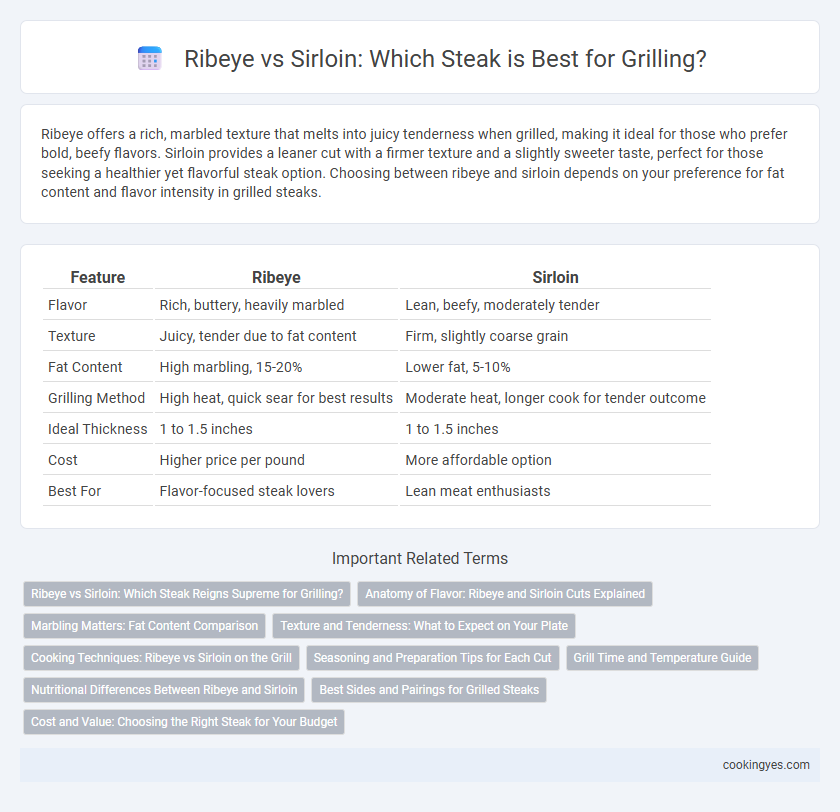Ribeye offers a rich, marbled texture that melts into juicy tenderness when grilled, making it ideal for those who prefer bold, beefy flavors. Sirloin provides a leaner cut with a firmer texture and a slightly sweeter taste, perfect for those seeking a healthier yet flavorful steak option. Choosing between ribeye and sirloin depends on your preference for fat content and flavor intensity in grilled steaks.
Table of Comparison
| Feature | Ribeye | Sirloin |
|---|---|---|
| Flavor | Rich, buttery, heavily marbled | Lean, beefy, moderately tender |
| Texture | Juicy, tender due to fat content | Firm, slightly coarse grain |
| Fat Content | High marbling, 15-20% | Lower fat, 5-10% |
| Grilling Method | High heat, quick sear for best results | Moderate heat, longer cook for tender outcome |
| Ideal Thickness | 1 to 1.5 inches | 1 to 1.5 inches |
| Cost | Higher price per pound | More affordable option |
| Best For | Flavor-focused steak lovers | Lean meat enthusiasts |
Ribeye vs Sirloin: Which Steak Reigns Supreme for Grilling?
Ribeye offers superior marbling and fat content, resulting in a juicier and more flavorful steak when grilled, while sirloin provides a leaner option with a firmer texture and slightly milder taste. For grilling enthusiasts seeking tenderness and rich beef flavor, ribeye is often considered the prime choice, especially for direct high-heat cooking methods. Sirloin remains popular for those preferring a leaner cut that still delivers satisfying flavor and versatility on the grill.
Anatomy of Flavor: Ribeye and Sirloin Cuts Explained
Ribeye steaks come from the rib section and feature rich marbling, which melts during grilling to enhance tenderness and impart a buttery flavor. Sirloin steaks are cut from the rear back portion, containing less fat but offering a leaner, firmer texture with a beefier taste. The anatomy of each cut directly influences grilling outcomes, with ribeye excelling in juiciness and sirloin prized for robust, meaty flavor.
Marbling Matters: Fat Content Comparison
Ribeye steaks are renowned for their abundant marbling, which consists of intramuscular fat that melts during grilling, enhancing tenderness and juiciness. Sirloin cuts have less marbling, resulting in a leaner steak with a firmer texture and a slightly lower fat content. When grilling, the higher fat content in ribeye provides more flavor and moisture compared to the sirloin's leaner profile.
Texture and Tenderness: What to Expect on Your Plate
Ribeye offers a rich marbling of fat that melts during grilling, resulting in a tender, juicy texture that enhances flavor with every bite. Sirloin provides a leaner cut with a firmer texture, delivering a more robust, beef-forward taste but less tenderness compared to ribeye. Expect ribeye to be buttery soft and succulent, while sirloin offers a chewier, heartier mouthfeel ideal for those who prefer a meatier steak experience.
Cooking Techniques: Ribeye vs Sirloin on the Grill
Ribeye steak offers rich marbling that melts into the meat during high-heat grilling, creating a juicy, tender texture ideal for direct flame cooking. Sirloin, being leaner, benefits from medium heat and shorter grilling times to prevent toughness while maintaining a robust beef flavor. Mastering temperature control and resting time enhances the natural qualities of both cuts for optimal grilled steak results.
Seasoning and Preparation Tips for Each Cut
Ribeye steaks benefit from a simple seasoning of coarse salt and freshly ground black pepper to enhance their rich marbling and robust flavor, while allowing the fat to render evenly during grilling. Sirloin requires a marinade or a dry rub with bold spices like garlic powder, paprika, and rosemary to tenderize the leaner cut and infuse it with additional taste. For grilling, ribeye should be cooked over high heat to achieve a caramelized crust without overcooking the fat, whereas sirloin demands careful monitoring and occasional flipping to maintain juiciness and prevent toughness.
Grill Time and Temperature Guide
Ribeye requires a grilling temperature of around 450degF and cooks in approximately 8-12 minutes for medium-rare due to its marbled fat content, which enhances flavor and tenderness. Sirloin, leaner with less fat, benefits from slightly lower heat at 400-450degF and a shorter cook time of 6-10 minutes to prevent toughness. Monitoring internal temperature is key: 130degF for medium-rare ribeye and 135degF for medium sirloin ensures optimal juiciness and texture.
Nutritional Differences Between Ribeye and Sirloin
Ribeye steak contains higher fat content, resulting in more calories and a richer flavor profile compared to sirloin, which is leaner with fewer calories and less saturated fat. Sirloin offers a higher protein-to-fat ratio, making it a preferred choice for those seeking a nutrient-dense, lower-fat option. Both cuts provide essential nutrients such as iron, zinc, and B vitamins, but ribeye's marbling contributes to increased fat-soluble vitamins like vitamin A and E.
Best Sides and Pairings for Grilled Steaks
Grilled ribeye pairs exceptionally well with rich, creamy sides like garlic mashed potatoes and sauteed mushrooms to complement its marbled, flavorful fat content. Sirloin, with its leaner profile, balances perfectly with lighter sides such as grilled asparagus, fresh chimichurri sauce, or a crisp arugula salad. Both steaks benefit from bold pairings like a robust red wine--Cabernet Sauvignon for ribeye and Merlot for sirloin--to enhance the overall grilling experience.
Cost and Value: Choosing the Right Steak for Your Budget
Ribeye steaks generally cost more than sirloin due to their higher marbling and richer flavor, offering excellent value for those seeking tenderness and juiciness in grilling. Sirloin provides a budget-friendly alternative with leaner meat that still grills well, making it ideal for cost-conscious consumers who prioritize portion size and versatility. Selecting between ribeye and sirloin depends on balancing your budget with the desired flavor profile and texture for your grilled steak experience.
Ribeye vs Sirloin for Grilling Infographic

 cookingyes.com
cookingyes.com